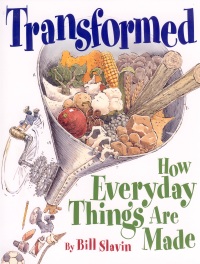| ________________
CM . . .
. Volume XII Number 4 . . . .October 14, 2005
excerpt:
Every product used by people has its origins in nature. This delightful book traces the transformation of 69 everyday objects from the raw material state to finished product form by means of step-by-step explanations and accompanying diagrams. Following an introduction, there are five main sections: Fun and Games, describing sports, hobbies and toys, such as teddy bears and surfboards; Around the House, featuring common household items like dental floss, wax candles and pet food; Soup to Nuts, highlighting foods and beverages, such as jellybeans and cola; Cover-Ups, which focuses on clothing and footwear; and Back to Basics, describing the manufacture of glass, lumber, rubber and other products from materials found in nature. In each section are several chapters consisting of double-page spreads. An amusing or interesting anecdote, often about the origins or history of the object, introduces the topic. Numbered steps, with short paragraphs, explain the manufacturing process in vocabulary that is fairly easy for readers to comprehend. Readers will learn, for example, how CDs are made, how a model ship is placed in a bottle, and even how water gets from a lake to individual homes. In a book of this type, it is difficult to find the fine line between too much (and complicated) information and not enough, yet in Transformed, the authors are able to do this very successfully. Measurements are provided in both metric and Imperial form. Fact boxes, comprised of trivia, history and new terminology, add colorful commentary to each topic and break the monotony of yet another described process. Some examples are the fact that fortune cookies were actually invented by a Japanese American as thank you notes to guests of his San Francisco tea house, and that the peanut butter factory recycles its peanut shells to use as fuel to heat the boilers that run the shelling machines. With so much information about so many different objects, another challenge for the authors is how to keep the material fresh and interesting. Bill Slavin easily meets this challenge with his wonderful watercolor and ink illustrations that depict cartoon-like workmen in overalls and caps performing the various tasks in the manufacturing process. Whether they are balancing on planks inside a giant guitar or bouncing up and down on a batch of pink bubble gum mixture, these little guys and their humorous antics add to the reader's enjoyment of the book. A table of contents, arranged alphabetically within each of the five sections, an index and a brief list of resources for further study are also included. Highly Recommended. Gail Hamilton is a teacher-librarian in Winnipeg, MB.
To comment
on this title or this review, send mail to cm@umanitoba.ca.
Copyright © the Manitoba Library Association. Reproduction for personal
use is permitted only if this copyright notice is maintained. Any
other reproduction is prohibited without permission.
NEXT REVIEW |
TABLE OF CONTENTS FOR THIS ISSUE
- October 14, 2005.
AUTHORS |
TITLES |
MEDIA REVIEWS |
PROFILES |
BACK ISSUES |
SEARCH |
CMARCHIVE |
HOME |
